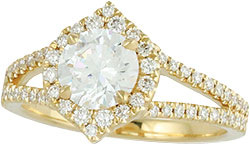|
In-Depth
Modern Marriage
Times have changed in the bridal business and retailers need to understand new niches and evolving social mores in order to compete.
By Lara Ewen
Bridal is one of the most important relationships a jeweler can cultivate. It’s big business, certainly, bringing in dollars and traffic. It’s one of the few reliable sources of customers. But bridal also serves as an emotional touchstone, helping to showcase the romance inherent in any jewelry purchase. For businesses looking to connect with customers in a world overrun by technology, love, not diamonds, drives the industry.
According to The Knot Real Weddings Study released in February 2017, couples were spending an average of $35,329 on their weddings in 2016, and an average of $6,163 on engagement jewelry. By contrast, The Wedding Report puts that cost at $26,720 for 2016, and $3,407 for engagement jewelry. The disparity in numbers may be a reflection of The Knot’s somewhat wealthier, urban audience, versus the federal, state and local government statistics compiled for The Wedding Report.
Even assuming that these averages will vary geographically, it’s fair to say that bridal is bringing in business. In September 2016, research firm IBISWorld estimated revenue for jewelry stores would increase a modest .5 percent year-on-year, to a total of $34.8 billion, boosted by a slight increase in per capita disposable income coupled with a slightly older and more financially stable first-marriage market than in years past. Many couples are now waiting until their late 20s or early 30s to tie the knot, which means they may be able to afford more expensive jewelry.
But shifting demographics don’t affect the business by itself and must be understood alongside other factors. According to retailers and jewelers across the industry, it’s technology that’s really changed the game over the past decade. “Online shopping has brought about the biggest changes to engagement ring shopping,” says Elizabeth Doyle, co-founder of Doyle & Doyle, a vintage and antique jewelry retailer and custom jewelry design house based in New York City. “It has opened up a world of possibilities formerly not available to many people. Ten years ago, shoppers were largely limited to their local jewelry stores. They may not have even known that an antique ring or an unusual design was an option. Now a simple online search will bring up more options than most people can imagine.”
Access to a wider variety of options has also increased the desire for custom and alternative products. “We have seen couples willing to consider alternatives to the traditional diamond ring more and more,” says Michael Magnotti, founding partner at EraGem and EraGem.com, a retailer based in Bellevue, Washington, just outside Seattle, that specializes in previously owned jewelry. “That’s likely due to their ability to see so many styles and options online.”
The industry needs to focus not just on product, but on messaging. “We own the engagement ring message,” says Liz Chatelain, owner of Austin, Texas–based MVI Marketing Ltd., a marketing and consumer research consultancy for the global gemstone, jewelry and watch industries. “So it’s ours to lose, and we need to make sure we’re always messaging. And we need to stop the constant sale price image. In our research, people constantly tell us they don’t trust the price because everything is a discount. So we need to have some steady, basic product that is not price-sensitive.”
Finally, the industry must recognize the need for expansive diversity when it comes to its customer base. “Every couple is different. People want a symbol of their commitment, and it doesn’t matter if you’re a gay couple or a straight couple or a third-marriage couple,” says Steven Messler, designer and owner of Tate, a contemporary jewelry design company based in New York City. “There’s no two diamonds exactly the same and there’s no two people who are exactly the same and no two couples who are exactly the same.”
 |
| Doves |
In order to dig deeper into the new normals, Rapaport Magazine has identified three niches that the industry has to connect with in terms of reach and message. If knowledge is power, then perhaps a better understanding of all segments of the population can help the industry turn the tide and regain a firmer footing.
YOU MUST HAVE JAVASCRIPT ENABLED TO VIEW THE SLIDESHOW
Article from the Rapaport Magazine - April 2017. To subscribe click here.
|
|